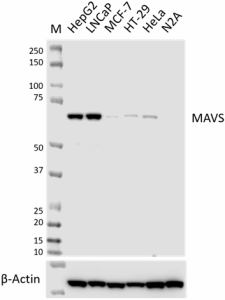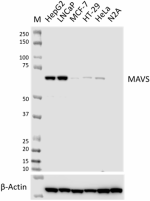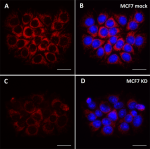- Clone
- W21144C (See other available formats)
- Regulatory Status
- RUO
- Other Names
- Interferon beta promoter stimulator protein 1, IPS-1, Virus-induced-signaling adapter, VISA, Mitochondrial Antiviral-Signaling Protein
- Isotype
- Rat IgG2b, κ
- Ave. Rating
- Submit a Review
- Product Citations
- publications

-

Whole cell extracts (15 µg total protein per lane) from the indicated cell lines were resolved on a 4-12% Bis-Tris gel, transferred to a PVDF membrane, and probed with the 1 µg/mL of Purified anti-MAVS (clone W21144C) overnight at 4°C. Proteins were visualized by chemiluminescence detection using HRP Goat anti-rat IgG (Cat. No. 405405) at a 1:5000 dilution. Direct-Blot™ HRP anti-β-actin (Cat. No. 664804) was used as a loading control at a 1:25000 dilution. Western-Ready™ ECL Substrate Premium Kit (Cat. No. 426319) was used as a detection agent. Lane M: Molecular weight marker -

MCF7 cells were fixed with ice-cold methanol and blocked with 5% FBS for 1 hour at room temperature. Cells were then intracellularly stained with 5 µg/mL of Purified anti-MAVS (clone W21144C) (green, panel A) and anti-HSP60 (Cat. No. 681502), followed by incubation with 2.5 µg/mL of Alexa Fluor® 488 Goat anti-rat IgG (Cat. No. 405418) and Alexa Fluor® 594 Goat anti-mouse IgG (red, panel B) (Cat. No. 405326) for 1 hour at room temperature. Nuclei were counterstained with DAPI (Cat. No. 422801) (blue, panel C). The image was captured with a 40X objective. Scale bar: 25 µm -

MCF7 cells (mock) (panels A and B) and MCF knockdown cells (panels C and D) were fixed with ice-cold methanol and blocked with 5% FBS for 1 hour at room temperature. Cells were then intracellularly stained with 5 µg/mL of Purified anti-MAVS (clone W21144C), followed by incubation with 2.5 µg/mL of Alexa Fluor® 594 Goat anti-rat IgG (Cat. No. 405422) for 1 hour at room temperature. Nuclei were counterstained with DAPI (Cat. No. 422801) (blue, panels B and D). The image was captured with a 40X objective. Scale bar: 25 µm -

IHC staining using Purified anti-MAVS (clone W21144C) on paraffin-embedded human testis (panel A) and human colon (panel B). Following antigen retrieval using 1X Citrate buffer (Cat. No. 420901), the tissue was incubated with 1 µg/mL of Purified anti-MAVS (clone W21144C) overnight at 4°C, followed by incubation with 2.5 µg/mL of Alexa Fluor® 647 goat anti-rat IgG (Cat. No. 405416) for one hour at room temperature. Nuclei were counterstained with DAPI (Cat. No. 422801) (blue). The image was captured with a 40x objective. Scale bar: 25 µm
| Cat # | Size | Price | Quantity Check Availability | Save | ||
|---|---|---|---|---|---|---|
| 624351 | 25 µg | $155 | ||||
| 624352 | 100 µg | $395 | ||||
Mitochondrial antiviral signaling protein (MAVS) is essential and specific for innate immunity by activating IRF3, IRF7 and NF-κB in response to viral infection. MAVS is located on the outer membranes of mitochondria, peroxisomes, and mitochondria-associated endoplasmic reticulum membranes (MAM). The MAVS protein contains an N-terminal CARD domain and a C-terminal mitochondrial transmembrane domain. MAVS acts downstream of the RIG-I RNA helicase and sensing viral RNA, leading to the recruitment of IKKε, TRIF and TRAF6. Some viruses have developed strategies to evade these innate defense mechanisms by using proteases that cleave MAVS and prevent its localization to mitochondria. The C-terminal region of MAVS cleavage by the hepatitis C virus (HCV) protease allows HCV to evade the host immune system.
Product DetailsProduct Details
- Verified Reactivity
- Human
- Antibody Type
- Monoclonal
- Host Species
- Rat
- Immunogen
- Partial Recombinant human MAVS protein
- Formulation
- Phosphate-buffered solution, pH 7.2, containing 0.09% sodium azide
- Preparation
- The antibody was purified by affinity chromatography.
- Concentration
- 0.5 mg/mL
- Storage & Handling
- The antibody solution should be stored undiluted between 2°C and 8°C.
- Application
-
WB - Quality tested
ICC, IHC-P - Verified - Recommended Usage
-
Each lot of this antibody is quality control tested by western blotting. For western blotting, the suggested use of this reagent is 0.125 - 1.0 µg/mL. For immunocytochemistry, a concentration range of 1.0 - 5.0 μg/mL is recommended. For immunohistochemistry on formalin-fixed paraffin-embedded tissue sections, a concentration range of 0.5 - 5.0 µg/mL is suggested. It is recommended that the reagent be titrated for optimal performance for each application.
- Application Notes
-
The clone does not cross-react with mouse in western blotting (WB).
For immunocytochemistry (ICC), we recommend to use 4% PFA fixation followed by permeabilization with 0.5% Triton X-100 or ice cold-methanol, or ice-cold methanol fixation.
For immunohistochemistry (IHC-P), antigen retrieval with Citrate Buffer (Cat. No. 420901) or Tris-EDTA pH 9.0 is recommended. - RRID
-
AB_3097498 (BioLegend Cat. No. 624351)
AB_3097498 (BioLegend Cat. No. 624352)
Antigen Details
- Structure
- MAVS protein is a 540 amino acid protein with a predicted molecular weight of 57 kD
- Distribution
-
Ubiquitously expressed, with highest levels in heart, skeletal muscle, liver, placenta and peripheral blood leukocytes
- Function
- Innate immunity
- Interaction
- RIGI, IFIH1/MDA5, TRAF2, TRAF6, C1QBP, FADD, RIPK1, CHUK, IKBKB and NLRX1
- Cell Type
- Epithelial cells, Leukocytes, Monocytes, T cells
- Biology Area
- Cell Biology, Immunology, Innate Immunity
- Molecular Family
- Innate Immune Signaling
- Antigen References
-
- Seth RB, et al. 2005. Cell. 122:669-82.
- Sun Q, et al. 2006. Immunity. 24:633-42.
- Xu LG, et al. 2005. Mol Cell. 19: 727-40.
- Yoneyama M, et al. 2004. Nat Immunol. 5:730-7.
- Lin R, et al. 2006. J Virol. 80:6072-83.
- Chen Z, et al. 2007. J Virol. 81:964-76.
- Li XD, et al. 2005. PNAS. 102:17717-22.
- Gene ID
- 57506 View all products for this Gene ID
- UniProt
- View information about MAVS on UniProt.org
Related FAQs
Other Formats
View All MAVS Reagents Request Custom Conjugation| Description | Clone | Applications |
|---|---|---|
| Purified anti-MAVS | W21144C | WB,ICC,IHC-P |
Compare Data Across All Formats
This data display is provided for general comparisons between formats.
Your actual data may vary due to variations in samples, target cells, instruments and their settings, staining conditions, and other factors.
If you need assistance with selecting the best format contact our expert technical support team.
 Login/Register
Login/Register 











Follow Us